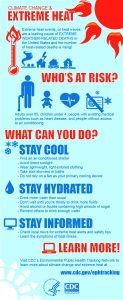Summer Fire Safety & Preparing for Extreme Heat
Emergency Preparedness is not exclusive to natural disasters. Make a plan to minimize the risk of harm. Please see below for this edition’s EM & DP Tips of the Month as produced by FEMA, READY.GOV, and the CDC.
FUN IN THE SUN
School is out, summer vacations are underway, and Fourth of July preparations have begun! The US. Consumer Product Safety Commission (CPSC) reports that an average of over 200 people go to the emergency department every day with fire-related injuries due to fireworks and outdoor cooking during the summer. Fireworks are dangerous! For more information and safety tips, please visit the CPSC’s website.
FIREWORK SAFETY
The Fourth of July holiday is coming up and that comes with an increased risk for fire and injury in firework-related incidents. Large grass crops and abundant vegetation, due to a wet winter, increase the threat for devastating wildfires throughout all of California.
Fireworks Safety Tips:
• Use only State Fire Marshal approved fireworks
• Local ordinances should be verified before purchasing and/or using fireworks
• Always read directions
• Always have an adult present
• Only use fireworks outdoors
• Never use fireworks near dry grass or other flammable materials
• Light one firework at a time
• Have a bucket of water and a hose nearby
Fireworks Injury Prevention Safety Tips:
• Never place any part of your body directly over a fireworks device when lighting the fuse
• Back up several feet immediately after lighting fireworks
• Never point or throw fireworks at another person
• Never experiment with fireworks
• Never attempt to re-light or “fix” fireworks
• Do not wear loose fitting clothing while lighting fireworks
• Never carry fireworks in your pockets
• Fireworks are not toys
San Bernardino County: “Safe and Sane” fireworks are only allowed in the following cities: Adelanto, Chino, Colton, Needles and Rialto, as well as specific locations in Fontana, Grand Terrace, and San Bernardino. Please call the fire department in these cities for more information. All fireworks are illegal elsewhere in the county. All fireworks that explode, shoot into the air, or move along the ground are termed dangerous and are illegal anywhere in California.
For more information please visit San Bernardino County Fire.
Riverside County: The cities of Blythe, Cathedral City, Coachella, Desert Hot Springs, and Indio are allowing the sale and use of State Fire Marshal approved “Safe and Sane” fireworks during the Fourth of July holiday. Those purchasing fireworks within these cities must not transport, sell, possess, store, or set-off fireworks outside the cities where the fireworks are purchased. Outside of these areas, fireworks are illegal in Riverside County.
For more information please visit Cal Fire.
QUICK TIPS
Handle Sparklers with Care
Some parents don’t realize that sparklers can cause serious harm to young children. Sparklers can burn up to temperatures of about 2,000 degrees, which is hot enough to melt some metals.
- Only individuals 12 years of age or older should be allowed to handle sparklers.
- Protect your animals!
- Their ears are very sensitive and can get loose quickly and even injured.
- Keep them locked up inside of the house – OUT OF HARM’S WAY!
IN CASE OF INJURY:
- Immediately take any injured child to a doctor or hospital emergency department.
In case of an eye injury, don’t touch, rub or flush out your child’s eye, as this may cause more damage.
- Instead, cut out the bottom of an empty paper cup, place it around the eye and immediately seek emergency medical attention.
If a burn occurs, remove clothing from the burned area, except for any clothing stuck to the skin.
- Run cool (not cold) water over the burned area and lightly apple a gauze bandage.
- Do not apply ointments, butter or other remedies on the burn.
- Seek emergency medical care if the burned area is large, looks infected (swelling, warmth, increased redness, increased pain or pus) or involves the face, hands, neck, feet, joints or genitals.
BEAT THE HEAT
According to the CDC, heat-related illness happens when the body’s temperature control system is overloaded.
NEVER LEAVE A CHILD, PET, OR AN ELDERLY INDIVIDUAL UNATTENDED INSIDE A VEHICLE. Even on an 80-degree day, within 10 minutes a vehicle heats to 90-degrees, and within 20 minutes the vehicle will reach 109 degrees – which is deadly to children. “ Infants and children up to 4 years of age are at greatest risk. Even young and healthy people can get sick from the heat if they participate in strenuous physical activities during hot weather. For heat-related illness, the best defense is prevention.”
- HYDRATE – drink plenty of water throughout the day
- Use sunscreen
- Apply 30 minutes BEFORE sun exposure
- RE-APPLY every TWO HOURS and after sweating/in water
- Dress in loose, lightweight, and light-colored clothing
- Use insect repellent while playing outdoors
- Prevents bites and mosquito/tick-caused diseases
- Limit outside time to 30 minutes when it is 90 degrees or higher
Heat-Related Illnesses are Preventable – Access PDF here.
- What to look for and What to do in case of:
- Heat Stroke
- Heat Exhaustion
- Heat Cramps
Other Safety Tips Handouts from FEMA and the CDC:
FEMA Extreme Heat Safety Graphics
FEMA: Be Prepared for Extreme Heat
Other Safety Tips:


